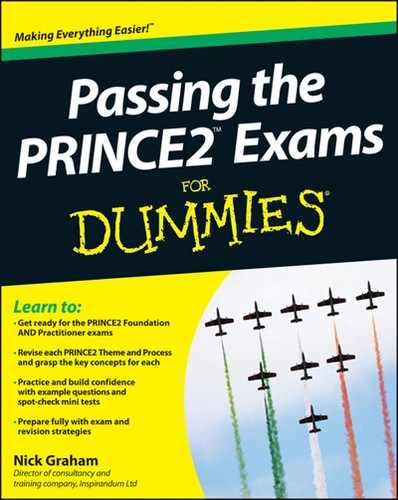For the Practitioner Exam Only
For the Practitioner exam, don’t forget these three additional preparation points.
Tabbing your manual
You can put sticky tabs on the page edges of your manual to help you find things quickly. Remember though that you can’t add extra information, just the name of the item. So, a tab on the page that lists the risk actions may be helpful. You’ll be able to find things in the manual anyway by flipping through, but if you can save a few seconds each time you need to find something, that mounts up to a worthwhile amount of time over the course of a two and a half hour exam. That time can be used for scoring marks, not trying to find things and discovering that they’ve been left out of the index to the manual (sad, but true – they really should have got John Wiley and Sons to publish it!).
Tabbing is a very personal thing. Some people use a single colour and tab up just a few essential items. Others visit the supermarket and get kits with different colour tabs, and then have the tabs running along the top and bottom of the manual as well as down the side. Someone on one of my courses did this recently, and I think the manual could have been submitted as modern art for the Turner Prize – it was certainly more attractive than a sheep cut in half or an unmade bed. In short, do whatever works best for you.
Knowing where stuff is
A really key point for Practitioner: know where stuff is. Don’t waste time trying to work something out or trying to remember detail when you can have the manual open at the page. Some things are general and some are specific and worth a tab on the page edge. So on specifics, the risk actions page and the Quality Review information are good for tabs. On general stuff, remember that at the end of every theme chapter in the PRINCE2 manual, there’s a list of the roles involved in that theme. At the end of each activity description within each process, there’s a table showing what products are in use in that activity and who’s involved.
Making notes
Under the current rules, you can write notes onto the surface of the pages of your manual – which is as it should be. Make notes alongside anything that you may need to refer to in the exam that isn’t already explained in the manual. That includes brief explanations on things where you think you may forget and the manual wording is less clear than it could be. However, don’t go to the opposite extreme of writing so many notes that you can’t find the one you’re looking for because of the mass of writing covering every square centimetre of white space.
You can also annotate your manual, so highlighting or underlining particular key points can be helpful too. As with the notes, though, don’t overdo it. If you highlight everything, you’ll just have a bright yellow manual, and you’ll be no better off finding a particular key point. Pretty, perhaps, but not very useful.
Remember, too, that while you can write onto the surface of the page of your manual, you’re not permitted to write reference notes on separate sheets of paper and slip them into your manual, or to write them on sticky notes and fix them onto the pages. A location tab simply saying ‘Risk Register’ stuck on the edge of the appropriate page in Appendix A is fine. Having extra information on the tab such as ‘set up by the Project Manager in Initiation’ is not okay.
